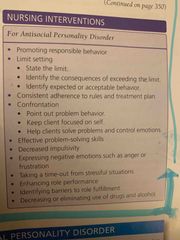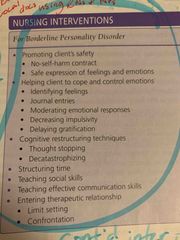![]()
![]()
![]()
Use LEFT and RIGHT arrow keys to navigate between flashcards;
Use UP and DOWN arrow keys to flip the card;
H to show hint;
A reads text to speech;
50 Cards in this Set
- Front
- Back
- 3rd side (hint)
|
Symptoms and characteristics of paranoid personality disorder include: |
Mistrust and suspicions of others Guarded restricted affect Conflict with authority figures due to fear |
|
|
|
Nursing interventions for paranoid personality disorder include: |
Serious, straightforward approach; teach client to validate ideas before taking action; involve client and treatment planning Be sure to validate the treatment idea before taking action |
|
|
|
Symptoms and characteristics of schizoid personality disorder: |
Detached from social relationships; restricted affect; involved with things more than people |
|
|
|
Nursing interventions for people with schizoid personality disorder: |
Improve clients functioning in the community; assist client to find case manager |
|
|
|
Symptoms and characteristics of schizotypal personality disorder: |
Acute discomfort in relationships; cognitive or perceptual distortions; eccentric behavior |
|
|
|
Nursing interventions for schizotypal personality disorder: |
Develop self-care skills; improve community functioning; social skills training |
|
|
|
Symptoms and characteristics for antisocial personality disorder: |
Disregard for rights of others rules and laws; deceit and manipulation; acts of cruelty; more psychotic behavior |
|
|
|
Nursing interventions for antisocial personality disorder: |

Limit setting; confrontation; teach client to solve problems effectively and manage emotions of anger or frustration due to lack of emotion |
|
|
|
Symptoms and characteristics of borderline personality disorder: |
Display false affect; unstable relationships, self image and affect; impulsivity; self mutilation |
|
|
|
Nursing interventions for borderline personality disorder: |

Promote safety; help client to cope and control emotions; cognitive restructuring techniques; structure time; teach social skills |
|
|
|
Symptoms and characteristics of histrionic personality disorder: |
Excessive emotionality and attention seeking; seductive; colorful; Exaggeration of closeness in relationships |
|
|
|
Nursing interventions for histrionic personality disorder: |
Teach social skills; provide factual feedback about behavior |
|
|
|
Symptoms and characteristics of narcissistic personality disorder: |
Grandiose; lack of empathy; need for admiration |
|
|
|
Nursing interventions for narcissistic personality disorder: |
Matter of fact approach; gain cooperation with needed treatment; teach client any needed self-care skills |
|
|
|
Symptoms and characteristics of avoidant personality disorder: |
Social inhibitions; feelings of inadequacy; hypersensitive to negative evaluation; shy |
|
|
|
Nursing interventions for avoidant personality disorder: |
Support and reassurance; cognitive restructuring techniques; promote self-esteem |
|
|
|
Symptoms and characteristics of dependent personality disorder: |
Submissive and clingy behavior; excessive need to be taken care of |
|
|
|
Nursing interventions for dependent personality disorder: |
Foster clients self-reliance and autonomy; teach problem-solving and decision-making skills; cognitive restructuring techniques; Encourage expression of losses |
|
|
|
Symptoms and characteristics of obsessive compulsive personality disorder: |
Preoccupation with orderliness, perfectionism, and control; However does not like being the center of attention |
|
|
|
Nursing interventions for obsessive compulsive personality disorder: |
Encourage negotiation with others; assist client to make timely decisions and complete work; cognitive restructuring |
|
|
|
Andeffective technique that involves stating that behavioral limit, identifying the consequences of the limit is exceeded, and identifying the expected or desired behavior |
Limit setting |
|
|
|
Techniques designed to manage manipulative or deceptive behavior where the nurse points out a clients problematic behavior while remaining neutral and matter-of-fact and avoids accusing the client |
Confrontation |
|
|
|
The pervasive mood involving unhappiness, restlessness, and malaise |
Dysphoric |
|
|
|
The technique useful in changing patterns of thinking by helping clients to recognize negative thoughts and feelings and replace them with positive patterns of thinking |
Cognitive restructuring |
|
|
|
A technique to alter the process of negative or self critical thought patterns such as I’m done when the thoughts begin the client can actually say stop in a loud voice |
Thought stopping |
|
|
|
A technique where the client reframe negative thoughts into positive thoughts |
Positive self talk |
|
|
|
A technique that involves learning to assess situations realistically rather than always assuming a catastrophe will happen |
Decatastrophizing |
|
|
|
Children who have a greater number of protective factors are less likely to develop antisocial behavior as adults. Give an example of protective factors. |
Cared for or shown love |
|
|
|
Personality develops through the interaction of (two answers) |
Hereditary dispositions and environmental influences |
|
|
|
What term refers to the biological processes of sensation, association, and motivation that underlie the integration of skills and habits based on emotion? |
Temperament |
|
|
|
Which personality disorders go with cluster A (odd or eccentric behaviors)? |
Paranoid, schizoid, schizotypal |
|
|
|
Which personality disorders go under cluster B (erratic or dramatic behaviors)? |
Antisocial, borderline, histrionic, narcissistic |
|
|
|
Which personality disorders fall under cluster C (anxious or fearful behaviors)? |
Avoidant, dependent, obsessive |
|
|
|
What are the four symptom categories that underlie personality disorders? |
1. cognitive perceptual distortions, including psychotic symptoms; 2. affective symptoms and mood dysregulation; 3. aggression and behavioral dysfunction; and 4. anxiety |
|
|
|
Low reward dependence corresponds to the categories of: |
Affective dysregulation, detachment, and cognitive disturbances |
|
|
|
Hi novelty seeking corresponds to: |
The target symptoms of impulsiveness and aggression |
|
|
|
Hi harm avoidance corresponds to the categories of: |
Anxiety and depression symptoms |
|
|
|
Cognitive perceptual disturbances include: |
Magical thinking, odd beliefs, illusions, suspiciousness, ideas of reference, and low-grade psychotic symptoms |
|
|
|
Many borderline personality disorder clients report disturbed early relationships with whom? |
Their parents; often began at 18 to 30 months of age |
|
|
|
Borderline personality disordered think about self and others often as polarized and extreme what is this referred to as? |
Splitting |
|
|
|
True or false? Borderline personality disorder is more common in men than women. |
False |
|
|
|
True or false? Character is the biologic process of sensation, association, and motivation that underlies the integration of skills and habits based on emotions. |
False; that would be temperament |
|
|
|
True or false? Individuals who have paranoid personality disorder May experience difficulty in trusting the members of the healthcare team. |
True |
|
|
|
True or false? Pharmacologic treatment of personality disorders is based on the symptomology rather than the particular subtype. |
True |
|
|
|
True or false? Individuals with avoidant personality disorder tend to demonstrate pervasive miss trust and suspiciousness of others and perceive others actions as potentially harmful. |
False; that would be paranoid personality disorder |
|
|
|
Which Personality disorder is characterized by pervasive pattern of disregard for and violation of the rights of others and with the central characteristics of deceit and manipulation? |
Antisocial |
|
|
|
Cognitive __________ is a process by which the clients our help to recognize negative thoughts and feelings and replace them with positive patterns of thinking |
Restructuring |
|
|
|
__________ is an ingrained enduring pattern of behaving and relating to self, others, and the environment and includes perceptions, attitudes, and emotions. |
Personality |
|
|
|
The pervasive mood and borderline personality disorder is ________, involving unhappiness, restlessness, and malaise. |
Dysphoric |
|
|
|
____________ personality disorder is characterized by a negative attitude and a pervasive pattern of resistance to demands for adequate social and occupational performance. |
Passive aggressive |
This is actually a personality trait not a disorder. |

